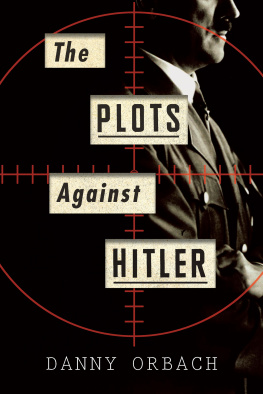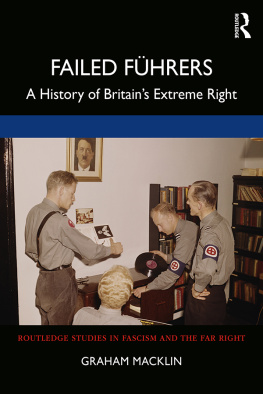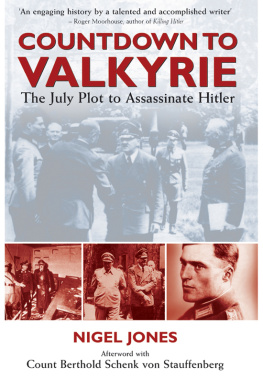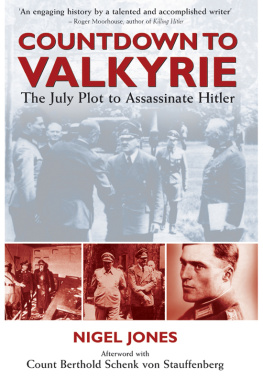Herbert Molloy Mason - To Kill Hitler: Plots on the Führers Life
Here you can read online Herbert Molloy Mason - To Kill Hitler: Plots on the Führers Life full text of the book (entire story) in english for free. Download pdf and epub, get meaning, cover and reviews about this ebook. year: 2016, publisher: CreateSpace Independent Publishing Platform, genre: Non-fiction. Description of the work, (preface) as well as reviews are available. Best literature library LitArk.com created for fans of good reading and offers a wide selection of genres:
Romance novel
Science fiction
Adventure
Detective
Science
History
Home and family
Prose
Art
Politics
Computer
Non-fiction
Religion
Business
Children
Humor
Choose a favorite category and find really read worthwhile books. Enjoy immersion in the world of imagination, feel the emotions of the characters or learn something new for yourself, make an fascinating discovery.

- Book:To Kill Hitler: Plots on the Führers Life
- Author:
- Publisher:CreateSpace Independent Publishing Platform
- Genre:
- Year:2016
- Rating:4 / 5
- Favourites:Add to favourites
- Your mark:
- 80
- 1
- 2
- 3
- 4
- 5
To Kill Hitler: Plots on the Führers Life: summary, description and annotation
We offer to read an annotation, description, summary or preface (depends on what the author of the book "To Kill Hitler: Plots on the Führers Life" wrote himself). If you haven't found the necessary information about the book — write in the comments, we will try to find it.
To Kill Hitler: Plots on the Führers Life — read online for free the complete book (whole text) full work
Below is the text of the book, divided by pages. System saving the place of the last page read, allows you to conveniently read the book "To Kill Hitler: Plots on the Führers Life" online for free, without having to search again every time where you left off. Put a bookmark, and you can go to the page where you finished reading at any time.
Font size:
Interval:
Bookmark:
TO KILL HITLER
The Attempts on the Life of Adolf Hitler
Herbert Molloy Mason
Herbert Molloy Mason 1978
Herbert Molloy Mason has asserted his rights under the Copyright, Design and Patents Act, 1988, to be identified as the author of this work.
First published in Great Britain in 1979 by Michael Joseph Limited.
This edition published in 2016 by Endeavour Press Ltd.
For
CAREY GOODWYN
Stalag Luft I
1944-45
Table of Contents
Foreword
In the winter of 1943 two German officers at a headquarters near Smolensk secretly experimented with plastic explosives to be used to assassinate the German head of state, Adolf Hitler. One of the plotters was a full colonel, the other a reserve lieutenant and respected peacetime jurist; their commanding officer considered them dedicated soldiers with brilliant wartime records. What would drive such men to choose the path of the assassin or, as some would later claim, to turn traitor at the height of a death struggle to determine the nations survival?
It is not generally realized that mortal opposition to Hitler began long before German armies became bogged down in Russia. The public did not know that many high-ranking, conservative members of the General Staff and other army figures consistently opposed, within the limits of their means, Hitlers plan to launch a second world war, a war these generals and field marshals knew Germany could not win. Once the war began, the rest of the world assumed that the brutally efficient series of conquests had been engineered long in advance by eager Prussian militarists acting in collusion with their F hrer. Exactly the opposite was the case.
Between 1919 and Hitlers rise to power in 1933, the German General Staff thought only in terms of defence against an attack from the east, where the Poles and the Czechs could mobilize 1.6 million troops between them. Limited by the Versailles treaty to a standing army of only 100,000 without tanks or heavy artillery (the air arm, eventually the Luftwaffe, was being trained secretly in Russia), the General Staff entertained no thoughts of starting a war of aggression.
Hitlers sudden appearance on the political scene in the 1920s at first raised no Prussian eyebrows. As one general, Georg von Sodenstern, said in postwar recollections, In the Army the impression was encountered in all quarters that Hitler could not amount to much, otherwise he would have got to be more than a corporal during the war.
In 1932 the German officer class was an elite; 24 percent of those with the rank of lieutenant and above belonged to the aristocracy, and almost to a man they were disgusted with the make-up of the senior Party leaders and the men they commanded. Hitler was an Austrian nobody; G ring a bloated caricature of a 1918 air hero, now addicted to morphine; Goebbels a dwarfish demagogue; Julius Streicher a Jew-baiter and pornographer and the Nazis martyred hero, Horst Wessel, had been a pimp. Hitlers original bodyguard, the brown-shirted storm troops, were street thugs to whom brawling and bloodletting were everyday occurrences, acceptable means of wielding power. In short, the majority of German officers looked upon the new rgime much as the West Point Association would have looked upon an American government in the hands of A1 Capone and Legs Diamond backed by men carrying tommy guns and brass knuckles. The comparison is not extreme.
But when Hitler started to woo the military with promises of a resurgent Reich based upon a modern rearmaments programme, he struck a responsive chord throughout the armed forces. A disarmed Germany lacking martial pride was intolerable to every man who wore field grey. General von Sodenstern points out that after 1933, Many succumbed to the dangerous self-deception that Adolf Hitler was basically a decent man with high ideals who, in possession of the power of the state, would get rid of the ugly concomitant phenomena of his movement.
But the ugly concomitant was what had brought Hitler to power and would keep him there by oppression and terror wherever the swastika flag was raised. Many officers realized this and continued to oppose Hitler even when National Socialism was at the zenith of its power and popularity. As early as 1938, detailed planning was carried out by ranking German commanders first to balk Hitlers plans, then to seize his person, then to kill him in order to halt the precipitate rush to conflagration. These plans were overhauled constantly during the following years as Germanys name was blackened by Hitlers desire to extend his conquests. The conspirators, always few in number, never flagged in their determination to rid Germany of the scourge of National Socialism, and many of them paid with their lives for their daring. They came close to succeeding in their attempts to assassinate the Fhrer on two occasions, and only flukes kept Hitler alive until G tter - dmmerung descended upon Germany in the spring of 1945.
The attitude toward those who staked all in their efforts to liquidate Adolf Hitler was summed up in a statement made to the U.S. army after the war by Sodenstern, who watched the rise and fall of the Reichs fortunes from the beginning. It was the German soldiers who brought themselves through difficult conflicts of conscience to the realization that legal methods could have no effect against the National Socialist terror. The path taken by these men was long and thorny. Their story deserves the appreciation of posterity because their actions had been barred not only by traditions of German soldierdom, which were hundreds of years old, but also by the professional ethics of all soldiers of the world. Here, then, is the story of those men who tried to kill the devil.
H. M. M.
Acknowledgments
The author is especially indebted to Mr. Robert Wolfe and Mr. John Mendelsohn of the Modern Military Branch, Military Archives Division, National Archives and Records Service, Washington, D.C., and to Dr. Anton Hoch, Archive Director of the Institut f r Zeitgeschichte in Munich, West Germany, for valuable guidance in gathering research material for this book. The National Archives holds thousands of rolls of microfilms of German records captured at the close of World War II, many of them dealing with German opposition to Hitler, and copies of these microfilms are available to the researcher.
Equally helpful were copies of interrogation reports of certain German officers who spoke freely to their U.S. Army captors. Obtained from the Office of the Chief of Military History and used here were the following transcripts in English: MS B-272, July 1944 , an interview with General G nther Blumentritt; MSA-855, History of the Attempt on Hitlers Life , an account of Colonel Rudolf von Gersdorffs own failed assassination attempt, and MS B-499, Events Leading up to July 1944 , by General Georg von Sodenstern, a perceptive examination of the inner conflicts individual German officers experienced between their oath to the Fhrer and the certain knowledge that Hitler was leading the nation to shame and destruction.
I wish to thank Mrs. Agnes F. Peterson of the Hoover Institution on War, Revolution, and Peace in Stanford, California; Mrs. Frances Hay of Mystole Park, Kent, England, a wartime member of MI-5, and Dr. Frank H. Panton, Director of the Propellants, Explosives, and Rocket Motor Establishment at Waltham Abbey in Essex, for supplying details of the British explosives used in the attempts on Hitlers life. And I owe thanks to Mr. Leif Hansen, of Fredrikstad, Norway, for securing copies of the Gestapo interrogation of Georg Elser, expertly translated by Mrs. Hildegard Adams of an Antonio.
I extend my appreciation to Mr. Thomas Wheaton Coward for the extended loan of his file on Wilhelm Canaris, including personal letters from General Franz Halder, General Achim Oster, Herr Josef M ller, the Countess Elisabeth Freytag von Loringhoven and from other survivors and relatives of those who opposed Hitler.
Next pageFont size:
Interval:
Bookmark:
Similar books «To Kill Hitler: Plots on the Führers Life»
Look at similar books to To Kill Hitler: Plots on the Führers Life. We have selected literature similar in name and meaning in the hope of providing readers with more options to find new, interesting, not yet read works.
Discussion, reviews of the book To Kill Hitler: Plots on the Führers Life and just readers' own opinions. Leave your comments, write what you think about the work, its meaning or the main characters. Specify what exactly you liked and what you didn't like, and why you think so.








